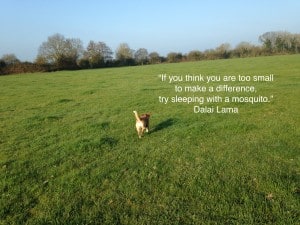Punishment never works in terms of learning, in any animal; human included. Punishment merely suppresses behaviour, which unfortunately is very reinforcing for the person administering the punishment because on the surface it appears to work as the “problem behaviour” stops (provided the experience is aversive enough).
But having administered punishment, the situation we now have is that the individual still feels the same about the trigger/issue, he just may not show it anymore, at this very point in time. Because he doesn’t dare. And he has one more problem now. Not only does he have the first issue, that made him feel so uncomfortable that he had to do something to try and fix it, to make the scary/annoying/frustrating thing go away. He now also fears the person that administered the punishment. Often a person he thought he could trust. A pillar of safety. Crushed. Now, we have created the perfect Russian Roulette: an individual that may blow any time he is exposed to the trigger, it is just that we won’t know when. Today? Tomorrow? Next month? And the individual’s owner/parent/guardian/partner/so-called-friend that administered the punishment thinks the individual is “cured” so he is expecting no such thing as a Russian Roulette…
Emotions motivate behaviour. It is adaptive to feel fear. Fear makes us jump away to safety, to run for the hills, or to hit back if we have to defend ourselves. Emotion is the reason we do what we do. Emotion is why a dog growls (as I wrote about earlier – in Swedish). Emotion is the why one person shouts at another. Emotion creates motion. And that is how it should be. But if we want to change that motion – to change that behaviour – then we need to change the emotion that motivates it.
What most individuals learn from punishment is “I can’t do this, when this person is around. This person now makes us feel unsafe.” Broken trust, increased frustration, increased fear and sometimes that apathy that comes with learned helplessness, with giving up…
True learning and positive change comes from being allowed to fail and still feel safe, from receiving help to increase your understanding about the problem/issue/trigger/scary-thing and help to learn to feel different about it. Man or mouse that is how it works. We are all functionally the same when it comes to emotions.
With carefully crafted, new, safe experiences the individual can change the way he or she feels about the situation. And when you change the way you feel about something, you change your behaviour towards it.
Us trainers, TTouch practitioners and behaviourists don’t advocate the use of positive, low stress methods to modify behaviour because we are sissys that don’t dare to administer punishment. We do it because it is scientifically proven to work best! And even if you are no good at it, at least you can’t do any harm. If you have doubts, then read Karen Pryor, read Jaak Panksepp, read Burch & Bailey, read Per Jensen, read Ken Ramirez, read Terry Ryan, read Patricia B. McConnel, read James O’Heare, read Suzanne Clothier, read Clive Wynne, read Temple Grandin, read Nicole Wilde, read Murrey Sidman, read Linda Tellington Jones, read Kathy Sdao, read Jean Donaldson, read Joseph LeDoux, read Alexandra Horowitz, read Adam Miklosi, read Anders Hallgren, and for God’s sake read John Bradshaw. You read them and you come back to me and tell me what you think about punishment.
Many of us have done the journey from ignorance to enlightenment when it comes to animal training and leadership. I am humbled by that journey and the more I learn the more I struggle with what I sometimes see in how we handle our animals and each other. There is a sense of urgency. I need to share what I have learned with as many as possible, as quickly as possible. And I will keep my Cesar Millan books in my bookshelf devoted to animal behaviour as a reminder of where I came from and to make sure I stay humble.

If you made it this far and would like to read some more, then please check out this wonderful blog which a friend of mine shared about why punishment doesn’t work for kids with ADHD, or read this exciting article about how and why we should change the way we ride our horses, or if you just fancy a feel-good story about a man who does some amazing things for dogs then check out this wonderful story.
I believe change is in the air. With science, kindness and knowledge we can change so many things for the better.







Fabulous!
I believe that change is happening at a great pace now and we do see more positive than aversive…..but there are still some mindsets that need to see change and that is part of our job.
You do a great job.
Thaaaaank you Stephanie!! It really is exciting times ahead. :D)